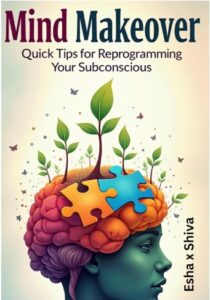
For More details you can check above mention book Buy at www.amazon.com

For More details you can check above mention book Buy at www.amazon.co.uk

For More details you can check above mention book Buy at www.amazon.fr

www.youtube.com/@TheEshaMarketing
Your subconscious mind controls 95% of your daily decisions, yet most people never learn how to communicate with it directly. These 5 mind hacks for success can help you reprogram your subconscious mind quickly without spending hours in therapy or meditation retreats.
This guide is perfect for busy professionals, entrepreneurs, students, and anyone wanting to break limiting beliefs and install new success patterns fast. You don’t need special training or expensive equipment—just 10 minutes and the right techniques.
You’ll discover powerful visualization techniques for mindset shifts that work in minutes, not months. We’ll cover positive affirmations scripts designed to slip past your inner critic and reach your subconscious directly. You’ll also learn breathing techniques meditation masters use to access altered mental states, plus simple self-hypnosis for beginners that creates lasting change.
Each method targets subconscious programming through different pathways, giving you multiple tools to transform your mental patterns. By the end, you’ll have a complete toolkit for behavioral transformation that fits into even the busiest schedule.
Visualization Technique for Instant Subconscious Programming

Create Vivid Mental Images of Your Desired Outcomes
Your brain can’t tell the difference between a vividly imagined experience and reality. This powerful phenomenon makes visualization techniques for mindset transformation incredibly effective for subconscious reprogramming. When you create crystal-clear mental movies of your goals, you’re literally rewiring your neural pathways to support success.
Start by choosing one specific outcome you want to achieve. Instead of vague wishes like “I want to be successful,” paint detailed pictures in your mind. See yourself walking into that job interview with confidence, shaking hands with the hiring manager, and hearing them say “You’re hired!” Feel the weight of your business card in your pocket as you exchange contact information with a potential client.
The key is specificity. Your subconscious mind responds to concrete details, not abstract concepts. If you want financial abundance, visualize the exact amount in your bank account, imagine the feeling of financial security, and picture yourself making purchases without stress. These detailed mental rehearsals create new neural pathways that guide your unconscious behaviors toward your goals.
Engage All Five Senses in Your Visualization Practice
Most people make the mistake of only using their visual sense during mental rehearsal techniques. Your subconscious mind becomes fully engaged when you involve all five senses in your visualization sessions. This multisensory approach accelerates behavioral transformation by creating richer, more convincing mental experiences.
As you visualize your desired outcome, ask yourself: What do you hear? Maybe it’s the sound of applause after your presentation, the ping of a notification confirming a sale, or the gentle hum of your dream car’s engine. What textures and temperatures do you feel? The smooth leather of your office chair, the warm handshake of a new business partner, or the cool ocean breeze during your ideal vacation.
Don’t forget taste and smell – these senses create particularly strong emotional connections. Imagine the taste of champagne celebrating a major achievement or the smell of fresh coffee in your new office space. Research shows that scent-linked memories are processed in the same brain region as emotions, making them powerful triggers for positive states.
Create a sensory checklist for each visualization session:
- Visual: Colors, lighting, people, objects
- Auditory: Voices, music, environmental sounds
- Kinesthetic: Textures, temperatures, physical sensations
- Olfactory: Scents that match your desired environment
- Gustatory: Tastes associated with celebration or success
Repeat Visualizations for Maximum Neural Pathway Strengthening
Consistency beats intensity when it comes to subconscious programming. Your brain builds stronger neural pathways through repetition, not through occasional marathon visualization sessions. Just like learning to ride a bike, the magic happens through regular practice that literally reshapes your brain structure.
Science reveals that it takes approximately 21-66 days of consistent repetition to form new neural pathways. This is why quick mind hacks for success require daily commitment, even if each session lasts only a few minutes. When you reprogram subconscious mind quickly, you’re essentially training your brain to automatically think, feel, and behave in alignment with your goals.
Schedule your visualization practice at the same time each day to build a powerful habit loop. Many successful people prefer morning sessions because the mind is naturally more receptive after sleep, while others find evening visualizations help program their subconscious overnight. Choose what works best for your schedule, but stick with it religiously.
Track your practice with a simple checklist or journal. Note any changes in your thoughts, emotions, or behaviors as you progress. You’ll often notice subtle shifts in confidence, decision-making, and opportunities within the first week of consistent practice. These early wins reinforce your commitment and accelerate your transformation process.
Remember, your subconscious mind doesn’t distinguish between repetition and reality. Each vivid visualization session is like a dress rehearsal for your actual success, training your mind and body to perform at peak levels when real opportunities arise.
Positive Affirmation Scripts That Bypass Mental Resistance

Craft present-tense statements that feel believable
Your subconscious mind acts like a skeptical friend who can spot fake confidence from miles away. When you tell yourself “I am a millionaire” while struggling to pay rent, your inner dialogue immediately pushes back with “Yeah right, tell me another one.” This mental resistance blocks the affirmation from taking root.
The secret lies in creating positive affirmation scripts that your current self can actually accept. Start with statements that feel like a gentle stretch rather than an impossible leap. Instead of “I am perfectly confident,” try “I am becoming more confident each day” or “I choose to speak up in meetings.” These present-tense affirmations acknowledge your growth journey without triggering disbelief.
Bridge affirmations work exceptionally well for subconscious reprogramming. Use phrases like “I am learning to…” or “I am growing into…” These create psychological safety while still programming your mind for positive change.
Use emotional language to amplify subconscious acceptance
Raw emotion acts as a direct highway to your subconscious mind. When you infuse your affirmations with genuine feeling, they bypass logical filters and embed themselves deeper into your mental programming. Cold, robotic statements like “I have good health” carry far less impact than “I feel vibrant energy flowing through my body.”
Transform bland affirmations into emotionally charged positive affirmations scripts by adding sensory details and feeling words:
- Basic: “I am successful”
- Emotionally charged: “I feel excited and proud as opportunities flow to me effortlessly”
- Basic: “I am loved”
- Emotionally charged: “I feel deeply appreciated and cherished by the people who matter most”
Your subconscious responds to the emotional frequency you broadcast. When you genuinely feel the emotions behind your words, you create stronger neural pathways that support lasting change.
Practice strategic repetition timing for deeper impact
The timing of your affirmation practice can make or break your subconscious reprogramming efforts. Your mind enters highly receptive states at specific moments throughout the day, creating windows of opportunity for deeper programming.
Prime timing windows include:
| Time Period | Mental State | Why It Works |
|---|---|---|
| First 10 minutes after waking | Theta brainwaves | Mind still in dream-like receptivity |
| Last 10 minutes before sleep | Alpha/Theta transition | Conscious guards are down |
| During physical exercise | Flow state | Analytical mind distracted |
| Post-meditation | Deep alpha state | Enhanced neuroplasticity |
Practice your affirmations during these windows using the 3-3-3 method: 3 minutes of focused repetition, 3 times per day, for 3 weeks minimum. This pattern aligns with your brain’s natural learning cycles and creates lasting neural changes.
Address limiting beliefs with counter-affirmations
Your biggest obstacle isn’t lack of positive thinking – it’s the negative programming already running in the background. These limiting beliefs act like mental bodyguards, protecting you from disappointment by keeping you small. Traditional affirmations often bounce right off these protective barriers.
Counter-affirmations work by directly addressing and neutralizing these limiting beliefs before installing new programming. First, identify your specific mental blocks, then create targeted responses:
Common limiting belief: “I’m not smart enough to succeed”
Counter-affirmation: “I have unique intelligence and learn quickly from every experience”
Common limiting belief: “Money is hard to come by”
Counter-affirmation: “Opportunities to earn money appear easily when I stay open and alert”
Use this two-step process: acknowledge the limiting belief without judgment, then immediately replace it with your counter-affirmation. This approach prevents your mind from fighting the new programming and creates space for positive change to take root.
The most effective counter-affirmations address the emotional core of your limiting beliefs rather than just the surface thoughts. Dig deeper to find the feelings behind your mental blocks, then craft affirmations that heal those emotional wounds while installing empowering new beliefs.
Power Breathing Methods to Access Altered States

Master the 4-7-8 Breathing Pattern for Rapid Relaxation
The 4-7-8 breathing technique serves as a powerful gateway to accessing altered states of consciousness for effective subconscious reprogramming. This method, developed by Dr. Andrew Weil, works by activating your parasympathetic nervous system and creating the perfect mental state for receiving new programming.
Start by placing your tongue against the ridge behind your upper teeth. Exhale completely through your mouth, making a whooshing sound. Close your mouth and inhale quietly through your nose for 4 counts. Hold your breath for 7 counts, then exhale through your mouth for 8 counts with that same whooshing sound. This creates one complete cycle.
The magic happens during the breath-holding phase. Your brain experiences a mild oxygen deficit that naturally shifts your brainwaves into alpha and theta states – the same frequencies present during deep meditation and REM sleep. These states make your subconscious mind incredibly receptive to new suggestions and programming.
Practice this breathing technique meditation for just 3-4 cycles when starting out. Your body will quickly adapt, and you’ll notice an immediate shift in consciousness. The beauty of this method lies in its accessibility – you can use it anywhere, anytime you need to access deeper mental states for transformation.
Synchronize Breath with Positive Intentions
Combining intentional breathing with focused thoughts amplifies the power of subconscious programming exponentially. Your breath becomes the delivery system for new beliefs and mental patterns, carrying them directly into your subconscious mind during those altered states.
As you inhale during the 4-count phase, mentally repeat a specific positive affirmation or intention. Choose statements that directly address what you want to reprogram. For example, breathe in while thinking “I am confident and capable” or “Success flows to me naturally.” The key is matching the rhythm of your thoughts to your breath pattern.
During the 7-count hold, visualize your intention taking root in your subconscious mind. Picture it settling into the deeper layers of your consciousness like seeds being planted in fertile soil. This visualization doesn’t need to be elaborate – a simple mental image of light or energy flowing into your mind works perfectly.
On the 8-count exhale, release any limiting beliefs or negative thoughts that contradict your new programming. Imagine breathing out doubt, fear, or old patterns that no longer serve you. This creates space for your new positive programming to take hold.
The synchronization creates a powerful rhythm that your subconscious mind recognizes and responds to. After just a few cycles, you’ll feel the shift as your new intentions begin integrating into your mental framework.
Use Breath Awareness to Quiet Conscious Mind Chatter
Your conscious mind’s constant internal dialogue often blocks access to subconscious programming. Breath awareness acts as a mental reset button, instantly quieting that mental chatter and creating the stillness necessary for deep transformation.
Focus entirely on the physical sensations of breathing – the cool air entering your nostrils, the expansion of your chest and belly, the warm air leaving your body. This simple act of attention immediately pulls you out of thought loops and into present-moment awareness.
When thoughts arise during your breathing practice (and they will), acknowledge them without judgment and gently return attention to your breath. Think of thoughts like clouds passing through the sky of your consciousness – observe them, but don’t engage with them. This process trains your mind to move beyond surface-level thinking into deeper states of awareness.
The goal isn’t to stop thinking completely but to create gaps between thoughts where your subconscious mind becomes accessible. These moments of mental stillness are golden opportunities for installing new programming. Even a few seconds of quiet mind space allows powerful subconscious shifts to occur.
Start with just 2-3 minutes of focused breath awareness. As your ability to maintain attention improves, extend the practice. You’ll discover that this simple technique becomes one of your most reliable tools for accessing the deeper levels of consciousness where real behavioral transformation occurs.
Quick Self-Hypnosis Techniques for Immediate Results

Establish Your Personal Relaxation Trigger Phrase
Your trigger phrase acts like a mental switch that instantly signals your mind to enter a relaxed state. Choose a simple, meaningful phrase that resonates with you – something like “deep calm now,” “peaceful mind,” or “entering my sanctuary.” The key lies in consistency and repetition.
Practice your trigger phrase during naturally relaxed moments like right before sleep or after a warm shower. Say it slowly three times while focusing on the sensation of relaxation spreading through your body. Your subconscious mind will begin linking this phrase with deep relaxation, creating a powerful anchor you can access anytime.
Test your trigger phrase’s effectiveness by using it during mildly stressful situations. Within 2-3 weeks of consistent practice, most people notice their body automatically responding to their chosen phrase with increased calm and receptivity.
Guide Yourself Into a Receptive Trance State
Creating a trance state doesn’t require special skills – you enter similar states naturally when absorbed in a good book or driving a familiar route. Begin by finding a comfortable position and focusing on your breathing. Count backward from 100, allowing your mind to drift if it wants to.
Progressive muscle relaxation amplifies this process. Start with your toes and consciously relax each body part moving upward. Tell each area to “let go completely” as you move through your legs, torso, arms, neck, and face. Most people reach a light trance state within 3-5 minutes using this method.
Watch for signs you’re entering trance: your breathing naturally slows, your body feels heavier or lighter, time seems distorted, or you notice increased mental imagery. These indicators show your conscious mind is stepping aside, allowing direct access to your subconscious programming.
Plant Specific Suggestions During Peak Receptivity
Peak receptivity occurs when your analytical mind is quiet but you remain aware. This sweet spot typically happens 5-7 minutes into your self-hypnosis for beginners session. Your suggestions should be positive, present-tense, and personally meaningful.
Instead of saying “I won’t be anxious,” use “I feel calm and confident in all situations.” Replace “I don’t want to fail” with “I succeed easily and naturally.” Your subconscious responds better to what you want rather than what you’re trying to avoid.
Repeat each suggestion 3-5 times with genuine emotion and conviction. Visualize yourself already living with these new patterns. The combination of relaxed brainwaves, positive language, and emotional engagement creates optimal conditions for subconscious reprogramming.
Create Post-Hypnotic Anchors for Lasting Change
Post-hypnotic anchors link your new mental programming to everyday triggers, ensuring your changes stick beyond the session. While deeply relaxed, imagine specific situations where you want your new behaviors to activate automatically.
Create physical anchors by pressing your thumb and forefinger together while visualizing your desired state. This gesture becomes a trigger for accessing that confident, calm, or motivated feeling instantly. Practice this anchor during your session, then test it throughout your day.
Mental anchors work similarly – choose specific environmental cues like doorways, phones ringing, or seeing your reflection as reminders to access your new programming. The more you practice these anchors, the more automatic your positive responses become.
Practice Safe Emergence Techniques
Proper emergence ensures you feel alert, refreshed, and grounded after your mental rehearsal techniques session. Never abruptly snap out of trance – this can leave you feeling disoriented or groggy.
Count slowly from 1 to 5, giving yourself positive suggestions at each number. “One, beginning to return… Two, feeling refreshed and energized… Three, becoming more alert… Four, almost fully aware… Five, eyes open, feeling fantastic.” Take a moment to stretch and move your body before standing.
If you practice before sleep, modify your emergence to transition into natural rest. Simply suggest that you’ll drift into peaceful, restorative sleep while your subconscious continues integrating your new programming overnight. This approach maximizes your subconscious programming 10 minutes daily practice while supporting healthy sleep patterns.
Strategic Mental Rehearsal for Behavioral Transformation

Script Detailed Success Scenarios in Your Mind
Creating vivid mental movies of your success acts like a blueprint for your subconscious mind. Your brain doesn’t distinguish between what you vividly imagine and what actually happens – this is why mental rehearsal techniques can trigger the same neural pathways as real experiences.
Start by choosing a specific goal or situation where you want to excel. Close your eyes and build a detailed scene where you’re already succeeding. Include every sensory detail: what you see, hear, smell, and feel. If you’re rehearsing a job interview, imagine the office environment, the interviewer’s voice, even the texture of the chair you’re sitting in.
The key is specificity. Instead of a vague “I’m successful,” create precise scenarios: “I’m confidently answering the question about my greatest weakness, maintaining eye contact, feeling calm and prepared.” Your subconscious absorbs these detailed mental scripts and begins preparing your mind and body to execute them in reality.
Spend 3-4 minutes on each scenario, replaying it multiple times with increasing detail. This subconscious reprogramming technique works because repetition creates neural pathways that make the imagined behavior feel familiar and achievable.
Practice Emotional Responses to Challenging Situations
Your emotional reactions often sabotage your success before you even realize what’s happening. Behavioral transformation methods require you to rehearse not just actions, but the emotions that support them.
Identify situations that typically trigger unwanted emotions – maybe it’s speaking up in meetings, handling criticism, or dealing with conflict. In your mind, recreate these challenging scenarios while practicing calm, confident emotional responses.
Start by imagining the trigger situation, but this time, see yourself responding with the emotions you want to feel. If public speaking usually makes you anxious, rehearse feeling excited and energized instead. Picture your body language reflecting confidence – shoulders back, steady breathing, clear voice.
The magic happens when you combine the emotional rehearsal with physical sensations. As you imagine feeling confident, actually straighten your posture and breathe deeply. This mind-body connection strengthens the neural programming and makes the new emotional response more accessible when you need it.
Practice different variations of the same challenging situation. This builds emotional flexibility and prepares your subconscious to handle unexpected twists while maintaining your desired emotional state.
Rehearse New Habits Until They Feel Automatic
Breaking old patterns requires more than willpower – it demands subconscious programming that makes new behaviors feel natural and effortless. Mental rehearsal bridges the gap between intention and automatic action.
Choose one habit you want to develop and break it down into specific, observable actions. Instead of “I want to exercise more,” rehearse “I’m putting on my workout clothes immediately after my morning coffee, feeling motivated and energized about my 20-minute walk.”
Run through the entire habit sequence in your mind, from trigger to completion. See yourself going through each step smoothly and naturally. Notice how good it feels to complete the habit. Your brain starts creating the neural pathways needed to make this behavior automatic.
The secret is rehearsing not just the action, but the entire context. Include the time of day, your location, what happens before and after. This contextual programming helps your subconscious recognize the right moments to trigger the new habit.
Repeat the mental rehearsal daily, ideally right before sleep when your subconscious is most receptive. Within days, you’ll notice the actual habit feeling more natural and requiring less conscious effort.
Build Confidence Through Repeated Mental Practice
Confidence isn’t built through positive thinking alone – it develops through experiencing success, even if that success happens first in your imagination. Visualization techniques for mindset create a foundation of successful experiences your subconscious can reference.
Select specific situations where you want to feel more confident. Maybe it’s networking events, difficult conversations, or creative presentations. Create detailed mental rehearsals where you handle these situations with poise and skill.
Focus on the internal experience of confidence – the calm certainty in your voice, the relaxed alertness in your body, the clear thinking that comes with feeling prepared. Your subconscious mind builds these confident states through repetition, making them available when you need them.
Each mental rehearsal should end with you feeling successful and satisfied. This positive emotional conclusion reinforces the entire experience and motivates your subconscious to recreate these feelings in real situations.
The compound effect of repeated mental practice creates what psychologists call “mastery experiences” – even though they’re imagined, they build real confidence that transfers to actual performance. Your subconscious doesn’t just learn what to do; it learns how it feels to do it well.

Your subconscious mind is incredibly powerful, and these five techniques prove you don’t need hours of meditation or expensive therapy sessions to create real change. Visualization, affirmations that slip past your mental defenses, power breathing, self-hypnosis, and mental rehearsal can all rewire your thinking patterns in less time than it takes to grab lunch. Each method taps into your brain’s natural ability to form new neural pathways quickly when you know exactly how to access the right mental state.
The best part is you can start using any of these techniques right now, wherever you are. Pick the one that feels most natural to you and commit to practicing it for just 10 minutes daily. Your subconscious is already listening and ready to change – you just need to give it the right instructions in a language it understands. Stop waiting for the perfect moment and start reprogramming your mind today.








